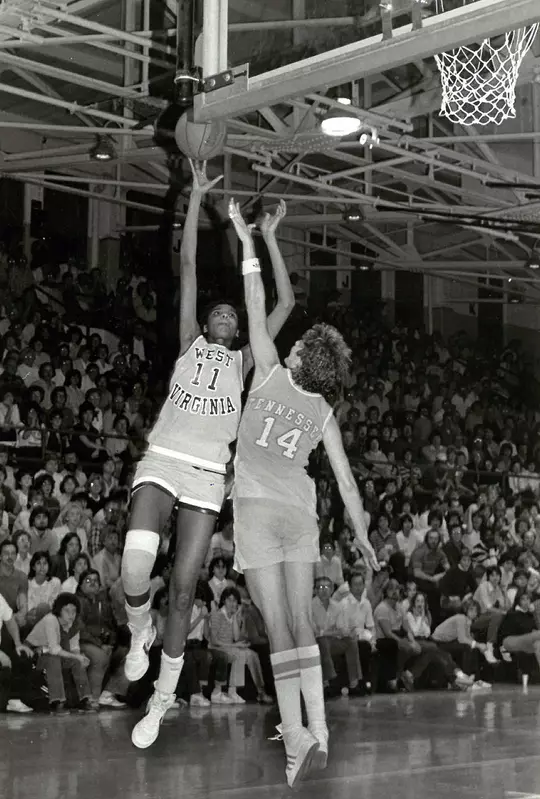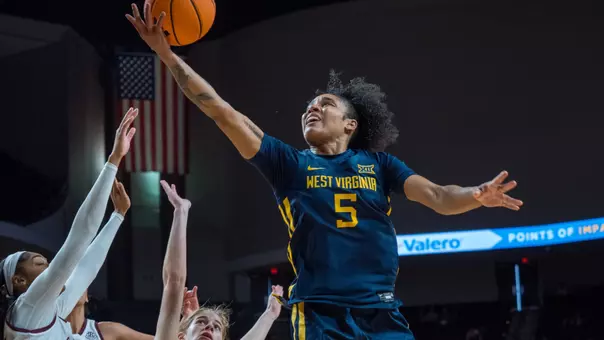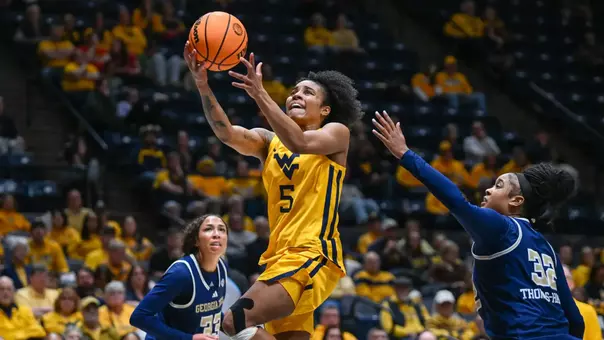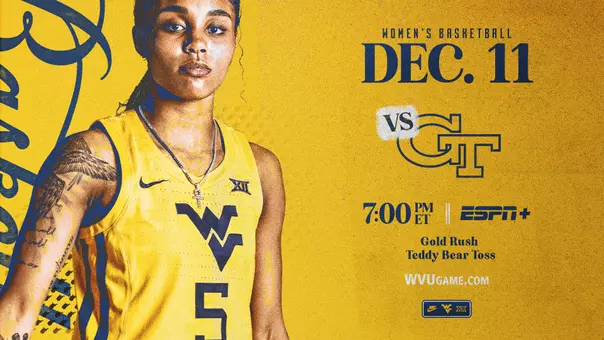WVU’s Wells the First Woman to Dunk in a College Game
February 18, 2022 09:00 AM | Women's Basketball, Blog
MORGANTOWN, W.Va. - Give Reed Albergotti an A+ for persistence.
The Wall Street Journal sports reporter managed to visually prove what no one else attending West Virginia University’s Dec. 21, 1984 game against the University of Charleston at the Randolph County Armory in Elkins could (or was willing to do) at the time – that WVU’s Georgeann Wells was the first women’s basketball player to dunk in a game.
And he finally did it 25 years after the fact!
The box score from the game said 715 people attended that night but those who were there say it was probably closer to 500, if that. Shelly Poe, West Virginia’s women’s basketball sports information director at the time, thought there might have been a reporter from the local paper covering the game, but they didn’t bring a photographer.
The two closest television stations, Clarksburg’s WBOY and WDTV, weren’t going to Elkins to cover a women’s college basketball game and West Virginia was light on team managers because the game was being played over Christmas break, meaning no one was available to film it.
“People were on vacation and I want to say there was something wrong with one of the cameras,” Poe recalled. “If we had two cameras, one was broken, or something like that, and Kittie (co-head coach Blakemore) was like, ‘That’s okay, the other team will film it.’ I want to say Davis & Elkins was also supposed to film the game but something happened and they didn’t.”
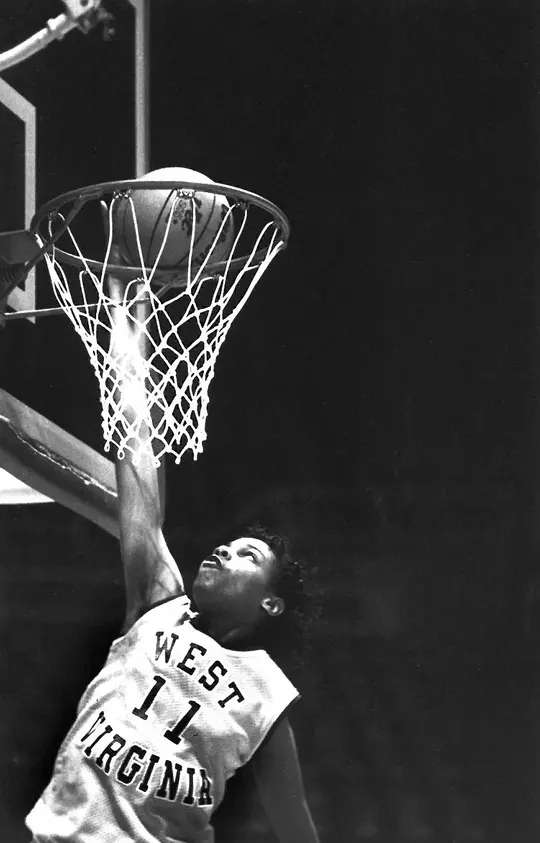
The only visual evidence of Wells dunking the ball existed on a VHS tape recorded by the University of Charleston, and its coach, Bud Francis, was not about to give it up.
The dunk and the nationwide attention it received at the time was strictly the product of Poe spending a couple of hours on a pay phone inside the arena describing it in great detail to the Associated Press.
No proof, just her word.
“I have to give Mel Greenberg a lot of credit,” Poe said. Greenberg covered women’s basketball for the Philadelphia Inquirer and was responsible for establishing the Associated Press Top 25 poll. “I talked to him before the season, explaining that Georgeann was capable of dunking and that this was a very real possibility and he said, ‘If this happens here is what you do …’”
Her promotional efforts got West Virginia women’s basketball coast-to-coast media coverage. This is what Cincinnati Enquirer readers saw on Saturday morning:
West Virginia University’s Georgeann Wells slammed home what is believed to be college basketball’s first dunk by a woman in the first round of the West Virginia Classic on Friday. Shelly Poe, of the West Virginia sports information office, said Wells, a 6-foot-7 junior, put home a right-handed dunk with 11:58 remaining in the second half of a game against the University of Charleston. The one-handed slam made the score 85-50, and West Virginia went on to win 110-82. Wells thought she had recorded a dunk in a game last season, but the basket was overruled because a foul had occurred before she took the shot.
That first dunk happened against Massachusetts and former WVU baseball player Bruce Clinton, refereeing the game, was the official who made the call to erase history. A picture of the dunk, taken by David L. Zicherman, is the one that is most frequently circulated today.
In the game in Elkins, Wells was standing at midcourt after Charleston had scored a basket and teammate Lisa Ribble, now Lisa Stolar, saw Wells lagging behind, so she grabbed the basketball and heaved it down the court in her direction.
The Columbus, Ohio, native caught it, took a couple of dribbles and jumped up and dunked the ball with her right hand. Veteran referee Bill Titus was the lead official on the two-man crew calling the game that night. The umpire was Keith DeVault.
“I knew she was going to dunk it,” Titus said.
“Bill and I both knew she was capable of dunking in practice and that’s about it,” DeVault recalled. “We didn’t pay attention to any of that. We were there to do a job and officiate the game to the best of our ability.”
Titus said his eyes were focused on Georgeann’s feet to make sure that she didn’t travel before going up to dunk it.
“I’ve got news for you; she wouldn’t have traveled anyway,” he laughed.
When Wells put the basketball through the rim - a men’s ball and not the smaller women’s ball that is used today – her teammates ran out onto the court to celebrate history.
“I had to call a technical foul after the dunk,” Titus recalled. “I told (coach) Kittie (Blakemore), ‘Sorry Kittie, but your whole team is on the floor.’ She didn’t care.”
But Bud Francis did. He didn’t like the fact that history was being made at his team’s expense and he wasn’t about to contribute anything else to it. West Virginia tried numerous times to get a copy of the dunk and Francis refused.
After a while, West Virginia finally gave up and soon the tape was lost to history, or so it seemed. Kittie assumed Francis had destroyed the recording and when Francis died in 1999, the mystery of the tape was seemingly lost to history.
Then, in 2009, on the 25th anniversary of the dunk, Albergotti tracked down Charleston attorney Ford Francis, Bud Francis’ son, to see if the tape still existed.
“There is no way I have this tape; why would I have the tape?” Francis told Albergotti. But when Albergotti mentioned that the game took place in Elkins, West Virginia, Ford recalled once seeing a basket of tapes that he had received from his father’s neighbor. The elder Francis had kept the tapes in a storage room in his barn and when he died, the neighbor discovered them and handed them over to Ford.
Written on one of the tapes was “W.V.U. - 84 Elkins.”
Ford called Albergotti and told him he had found the tape, and Albergotti got on a plane and flew down to Charleston to see it for himself and make a copy of it.
“I was completely excited,” Albergotti told ESPN.com senior writer Greg Garber in 2009. “For me, my emotion as a reporter, I found a piece of history.”
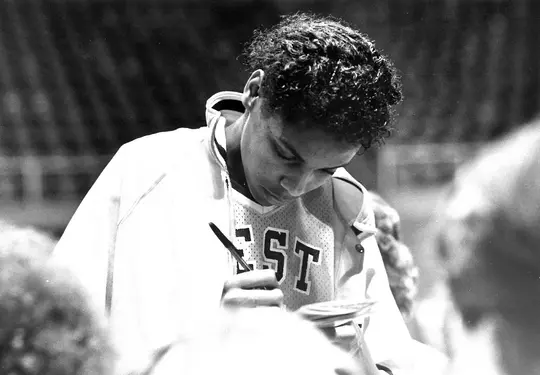
Dunking the ball was the defining moment of Georgeann Wells’ college basketball career. She did it once more a week later against Xavier at the U.C. Fieldhouse in Cincinnati, Ohio, and the circumstances were similar. She took a long pass from a teammate on the right side of the key, dribbled and slammed the ball through the basket with her right hand.
“This one was awesome,” Wells said of her second one. “It was much better than the first one. I had confidence all the way that I could do it. On the first one I was kind of scared, but now I know I can do it. I felt a little pressure because everybody’s expecting me to do it now.”
Those two dunks brought considerable national attention to West Virginia women’s basketball, which is exactly what co-head coaches Blakemore and Bill Fiske were seeking – particularly Fiske, who encouraged Georgeann to practice her dunking before practice each day.
“Kittie was first-class all the way, and this was not going to be a stunt or whatever,” Poe recalled. “We were going to have to be comfortably ahead in the game or it was going to have to be wide open. That was going to be the thing going into the deal and, of course, the other teams didn’t want to be the one getting dunked on.”
Afterward, Poe fielded steady media requests for Georgeann. If she was playing in a major media market against, say, George Washington, a feature story appeared in the Washington Post. It was the same deal in Philadelphia when West Virginia played St. Joseph’s or Temple.
George Vecsey profiled her for the New York Times and USA Today had her as one of its celebrity Super Bowl selectors when the San Francisco 49ers defeated the Miami Dolphins 38-16 in 1985. Some of the other celebrities included were comedian Bob Hope, noted psychologist Dr. Joyce Brothers, “Knight Rider” actor David Hasselhoff and tennis star Martina Navratilova.
The University of Houston men’s basketball coach Guy Lewis wrote Georgeann a letter officially welcoming her as an honorary member of Phi Slama Jama, the name given to his high-flying, slam dunking teams, and she was also invited to attend an NCAA women’s sports symposium in New York City.
“There was a chance for her to be on the Today Show but some world event happened and she didn’t get on,” Poe recalled. “This was something new for women’s basketball, and it was somebody new, not a player from Tennessee or one of the power schools.”
USC star Cheryl Miller could also dunk at the time, but she wasn’t able to do it in a game. Had it been Miller who was the first to dunk in a college game instead of Wells, it would have just been a part of her great career, not its defining aspect.
Wells was a very good college player, scoring 1,484 points and grabbing 1,075 rebounds during her four seasons at WVU, but she was not in the same category athletically as Lisa Leslie, Candace Parker, Brittney Griner or the other dunkers who came after her.
One other thing to consider about Wells’ two collegiate dunks – she had a great rebounding teammate in Olivia Bradley who made it possible for her to get out in the open for dunking opportunities.
Titus, who retired from officiating in 2018 after 48 years, was assigned to referee a game at Xavier late in his career. As he walked onto the floor, he noticed a tall, thin lady stand up and approach him. He knew exactly who it was – Georgeann Wells. Her daughter Maddison Blackwell was playing for the Musketeers.
“She came down the steps and gave me a hug and she said, ‘You are still not refereeing are you?’ I said, ‘Well, I’m dressed in stripes, I’ve got my shoes on … yeah, I think I am.’ She goes, ‘Well, you’ve got my daughter!’”
Wells was inducted into the West Virginia University Sports Hall of Fame in 2007. Had she dunked today for the first time, she would have profited greatly with Name, Image and Likeness.
“It’s sad that she didn’t get a chance to take advantage of it like they can today. She is such an engaging person and anyone who met her instantly liked her,” Poe concluded.
